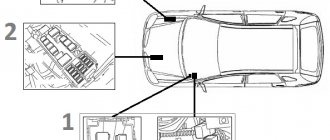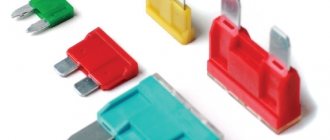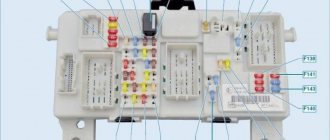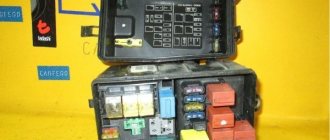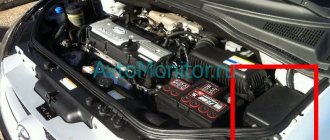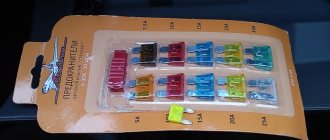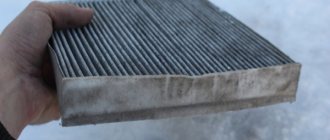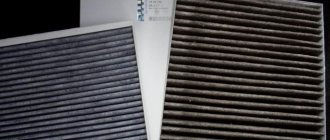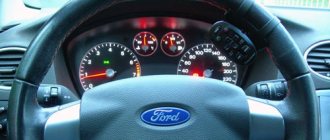The first fuse box for Ford Focus 2 is located near the driver's fender under the hood, near the battery. To check or replace the PCB, you need to remove the cover and use tweezers attached to its reverse side. Relays and large fuses can be reached by hand.
On the inside there is a diagram of the location of the PP. It fades over time, in which case you can print a new one and attach it to the lid.
Decoding the engine compartment fuse module for the Ford Focus 2
| № | Denomination, A | Device or circuit being protected |
| 1 | 40 | Coolant fan motor |
| 2 | 80 | Electric power steering |
| 3 | 60 | Cabin module PP |
| 4 | 60 | Cabin module PP |
| 5 | 80 | Climate control, air conditioning |
| 6 | 60 | Spare connector |
| 7 | 30 | ABS unit electric pump |
| 8 | 20 | ABS valve body |
| 9 | 20 | Main Relay, winding |
| 10 | 30 | Heater fan motor |
| 11 | 20 | Engine power supply breaker |
| 12 | 40 | Engine start power connector |
| 13 | 20 | Starter fuse |
| 14 | 40 | Right heated windshield |
| 15 | 25 | Auxiliary radiator fan relay |
| 16 | 40 | Left heated windshield |
| 17 | Spare connector | |
| 18 | Spare connector | |
| 19 | 10 | ABS system, control unit |
| 20 | 15 | Klaxon |
| 21 | 25 | Webasto, for cars with northern preparation |
| 22 | 10 | Electric power steering, Control unit |
| 23 | 30 | Headlight cleaner nozzle pump |
| 24 | 15 | Spare connector |
| 25 | 15 | Heated windshield relay, power winding |
| 26 | 10 | ECU fuse for cars with automatic transmission |
| 27 | 10 | Air conditioner clutch drive |
| 28 | 10 | Spare connector |
| 29 | 10 | Climate controller control |
| 30 | 3 | Engine, ECU. Automatic transmission, ECU |
| 31 | 15 | Battery charge controller fuse |
| 32 | 10 | Automatic transmission rocker position selector |
| 33 | 15 | Lambda probe heating |
| 34 | 15 | Coils, electric fuel injectors |
| 35 | 15 | Engine, control unit |
| 36 | 10 | ECU |
Relay and fuse blocks Ford Focus 2.
Relay and fuse blocks Ford Focus 2.
Relay and fuse blocks Ford Focus 2_ttl
Sometimes there are times when one or another electrical equipment in a car stops working, and, of course, first of all it is necessary to check the integrity of the fuses that protect these electrical circuits. Actually, we won’t write long prefaces to the article, and let’s get straight to the point. Below we will provide images of relay blocks and fuses of the Ford Focus 2 car with numbered elements, and tables of correspondence of these numbers to their functional purpose. This car model contains two such units, the first is located in the engine compartment under the hood next to the battery and air filter under a plastic cover, the second unit is located in the cabin under the front panel glove compartment opposite the passenger seat. And so, in order.
Engine compartment relay and fuse mounting block.
Appearance and numbering of elements installed in it:
Elements numbered with the letter “F**” are fuses, those marked “R**” are relays.
Engine compartment block fuses and their purpose:
Table of assignment of the FF-2 engine compartment relay:
Relay and fuse box under the glove compartment in the passenger compartment.
Appearance and numbering of elements:
Just like in the first block, the letter “F**” indicates fuses, relay R15 is not activated, the fuel pump receives power through relay R19.
Fuses of the unit in the cabin and their purpose:
Starter and generator power circuit fuse FF-2.
This fuse is located on the positive terminal of the battery. See image below:
The rated currents of fuse links are marked on the fuse housings.
We hope the article will be useful to owners of Ford Focus 2 cars.
Replacing parts
The cause of the block board failure is a sudden voltage drop. The process melts the contacts and can kill the device. Water ingress is also a common cause. Any electronics are afraid of moisture and dust.
Replacing the generator regulator relay
After you have learned how to check the voltage regulator and determine that the module is faulty, you should replace it. The procedure itself looks extremely simple. The wiring chip is disconnected from the terminal. Next, the block is unscrewed and replaced with a new element.
Replacing the windshield wiper relay
You will need to pull the device body. Insert the working part into the vacant space.
Replacing the wiper relay
The procedure is similar to changing other elements.
Replacing the solenoid relay
It is more difficult to replace the retractor element, but it is possible to do it yourself.
- Place the car on a level surface and raise the handbrake all the way.
- Remove the terminals from the battery.
- Get under the car and unscrew the 9 engine protection screws.
- Next, the starter itself is shown. Here you will need to disable the chips of the interfering elements of the on-board circuits.
- Next, you need to unscrew the three screws that secure the starter to the engine block.
- After this, you can completely remove the device from the machine.
- The last stage is to turn off the retractor. To do this, three screws are unscrewed and the part is simply removed from the seat.
Possible reasons for car electrical repairs
Since almost all elements of modern cars exclude electronic control, being based on a separate or systematized electrical circuit, in the event of any breakdown, the failure of this particular element must first be excluded.
And most often, the following sudden problems or malfunctions speak in favor of this recommendation:
- Interruptions in the operation of the electrical system as a whole, failure of wipers, interior lighting and external light optics (headlights).
- Temporary or frequent switching on and off of individual devices, which may indicate oxidation of a certain contact in the circuit.
- General interruptions here and there, often indicating that water has entered the system.
- Sequential failure of all systems with electrical power from a common circuit.
- There is a distinct burning smell in the car, which requires immediate attention to prevent fire.
That is, it is still possible for one or several systems to fail at once, despite the presence of autonomous fuses. This is explained by the fact that several automotive devices can be connected to the same safety element at once.
How to turn off the cigarette lighter
A constantly running device can cause breakdown of on-board network components. To resolve this issue, it is recommended that you find ways to disable it. In order for the device to stop working after turning the key in the ignition switch, an additional relay is introduced into the circuit. This way the cigarette lighter will not be powered when the engine is off. You can completely disconnect the device to be switched off from the on-board network by removing the wires. However, it will not be possible to use it for its intended purpose even after starting the engine.
- A set of tools for cars in a suitcase is inexpensive but good
- The best polish for plastic in the car interior
- Cigarette lighter fuse Kalina 1
- Rating of car seats for children
How to check if the fuse is working properly on a Ford Focus
There are several basic methods for checking the serviceability of the Ford Focus fuse:
- visual;
- replacement method;
- multimeter.
The simplest method is considered to be by replacement. You just need to install a new fuse in place of the potentially faulty device. But it is fair to consider this technique identical to visual inspection. After all, it is easier to determine by external aspects than to change each of the fuses located in the block in a row.
Visual fuse check
Let's start with how to understand whether a fuse has blown in a car, based purely on the appearance of the element. This method is considered the most correct, since it is quite easy for many people to visually verify that a breakage of a low-melting component has occurred. To check, you will need to remove the element, bring it to the light and look at it carefully.
It will not be difficult for an experienced motorist to find out and understand whether the fuse in his car has blown or not. Beginners do not understand this right away, which raises several more questions regarding how to get an accurate answer. A worn fuse is not difficult to identify. This manifests itself in the form of broken wire (low-melting alloy) or burnt marks.
Symptoms such as these indicate that the electrical circuit has broken and the fuse needs to be replaced. A similar testing method is relevant for those fuses that are made from glass or transparent plastic. Most of them are found in passenger cars. But the method also has a significant drawback. The test is performed by a person, without the use of any instruments.
In some cases, especially for beginners, a visual examination does not provide a 100% guarantee of a correct diagnosis. Therefore, it is much more correct and efficient to check fuses using multimeters.
Checking the fuse with a multimeter
This is a great way to identify a blown fuse in your car. Anyone can calculate using this method, since there is nothing particularly complicated in the procedure. The only condition is to have a multimeter.
You can also check with a regular tester, but a multimeter can later solve a number of other issues. This is a more versatile device. Having a car multimeter in your hands, you should understand in more detail how to independently check a potentially blown fuse. Using such a device, verification is performed using 2 methods:
- by voltage;
- by resistance.
Let's start with a technique that involves checking the condition by voltage. Here you need to perform the following procedures:
- turn on the measuring device in voltage test mode;
- turn on the electrical circuit of the machine where there are problems;
- check the voltage parameters at one terminal of the protective element, and then at the second;
- if there is no voltage at one of the terminals, the device has burned out and needs to be replaced.
The method is extremely simple, for which it is appreciated by motorists. Just a couple of minutes is enough to verify that the fuse is working or confirm that it has failed.
But in certain situations, checking by voltage is not very easy. This mainly concerns the fuses responsible for the operation of the horn and door lock. This is where an alternative method comes to the rescue. If for some reason the voltage test is not suitable for you, use the resistance diagnostic method.
- The multimeter switches to Ohm measurement mode. These are units of resistance; the terminals of the measuring device are connected to the terminals of the fuse;
- if the screen is zero, the element has failed and needs to be replaced.
And there is nothing complicated here, because even a novice motorist who has only recently started operating a vehicle independently can easily cope with the task.
In fact, to check you only need a little free time and a good multimeter with the appropriate measurement modes. It’s not difficult to buy a device, but its capabilities are enormous in terms of self-diagnosis of a car.
Removal and replacement process
Replacing the fuse is a simple process and requires virtually no tools.
What you need
- tweezers;
- flat screwdriver;
- new fuse.
In the engine compartment
In order to gain access to the fuses located in the engine compartment of the Ford Focus 2, you need to open the hood. The block is located in a convenient place - to the right of the engine, and is a small black plastic box.
Electrical fuses in the block
You can open it with a regular flat-head screwdriver; you just need to pry off the lid.
Layout on the cover
Also note that on the back of the cover there is a diagram of the location of the fuses and tweezers, with which replacement is carried out. You will need it when you need to change the fuses in the block under the glove compartment.
Under the glove compartment
The second unit under the glove compartment on the Ford Focus 2 is also in a convenient location, and to access it, you need to pull down to remove the protective shelf.
Ford Focus 2 - Where is the Main Relay?
#1 Sorokin_Vadim
- APC-Users
- 440 messages
- Moscow city
- Gender: Man
I had to help my friends, despite the complete lack of any experience and knowledge of the “branded features” of this device, so some of the questions will probably seem extremely stupid, for which I apologize in advance.
So: Focus 2006, DURATEC VCT 1.6L suddenly stopped starting, the starter turns and that’s it.
They asked me to help, because there were no familiar Ford specialists, and it was awkward for me to refuse right away, maybe it was some kind of nonsense. I downloaded the first program I found on the internet - FORScan - and went to look.
There is no spark. I confess, I didn’t look at the pulses on the injectors, because I read the errors and switched to them, it seemed more interesting. The fuel pump turns on when the starter starts, there is pressure.
There are three permanent errors in the system:
0686-72 high main relay voltage 0562-71 low system voltage (maybe this is a consequence of the upper error?) The battery is charged.
1000-70 (damn, I didn’t write it down, there was something complicated about diagnostics, and now I forgot the decoding, but IMHO this is something secondary).
And here’s the actual question: in Opel the main relay is an important thing, I thought in Ford we also need to start with this error, SO WHERE IS THIS RELAY?
There are two types of relay locations on the engine compartment relay and fuse block posted on the Internet.
In the first case, this is relay R6
We have a second option:
In this version there is simply no main relay. All other relays have other purposes, relay R8 is not the main relay, it is an ignition relay, on the contrary, it turns off some consumers at startup, as I understand.
Who knows this device, please tell me:
1. Am I looking in the right direction?
2. If the correct one, then where to look for this relay? There is an error, which means the relay is probably still there.
(Although, Opel has errors in the main relay circuit P1230, P0681 - this is quite unpleasant and does not always indicate a breakdown of the relay).
Maybe I started my search in the wrong place.
Thank you in advance to those who will not pass by
- Top
- Nickname or quote
#2 Conon9
+75
- City: Surgut
- Gender: Man
www.86chip.ru
- Top
- Nickname or quote
#3 Sorokin_Vadim
- Moscow city
- Gender: Man
Can you tell me the pin number or will everything be immediately visible based on the state of the wiring?
- Top
- Nickname or quote
#4 Conon9
+75
- City: Surgut
- Gender: Man
Why do you need a relay
As a rule, various car mechanisms are connected through a fuse, but the fuel pump is so powerful that a relay was provided for it. On Ford Focus cars it can be located in two places, depending on the year of manufacture. On older models released before the restyling of the 2nd generation Ford Focus, the relay is located in the black box (block) and in the passenger compartment. The second unit is fixed directly under the glove box.
The pump relay is marked in the diagram as K4
On new restyled models, the relay is installed in the mounting block in the passenger compartment.
The fuel pump relay is marked in the figure as R19
The fuel pump relay on a Ford Focus performs very important functions. It controls the operation of the pump, starts the starting injector (when starting the internal combustion engine) and at the same time heats the oxygen sensor. It is not surprising that solving so many problems, it deteriorates over time.
The malfunction of the relay can be determined either by the operation of the fuel pump itself or by force. In fact, it is the relay that turns the pump on and off, based on pressure readings in the system. When the pressure increases, the relay turns off the pump, and vice versa, when the pressure decreases, it turns it on. If the pump does not turn off after certain periods of time, we can conclude that the relay is damaged.
To check the operation of the relay directly, you should close two of the five vertical contacts. The pump should turn on. Replacing the relay is easy. It is carried out like any replacement of large fuses, without the use of special tools. You just need to remove the old one and install a new relay with your own hands.
If the pump will be replaced at a service station, we recommend requiring workers to guarantee the quality of the parts being installed. In addition, we advise you to buy original spare parts when replacing them yourself, so that they last a long time.
Good afternoon My name is Mark. I am 40 years old. By education - teacher.
Where is the fuse box in the Focus?
The second generation Focus can be roughly divided into two versions of cars - before restyling until 2007, as well as cars after restyling from 2007 to 2011. But the change in image did not affect the electrical circuits. The car has two blocks left, each of which has retained its quite convenient placement. The location of the fuse box in Ford Focus 2 is quite clear:
- The cabin module is located at the passenger's feet. You can see it under the glove box if you bend over a little. To remove burnt fuses, you will need special pliers; it will be very difficult to perform the procedure with your hands.
- The second block is located under the hood. You need to look for it on the left side, not far from the car’s battery. The block is presented in the form of a black plastic box with a diagram on top; it is not difficult to find. Also, on the original cover you can often see the location of the fuses and find out what they are responsible for.
There is a fuse on the cover of the engine compartment, it is not difficult to find. Under the cover there are mounts for plastic tweezers and spare fuses, but in used cars there are often no tweezers or spare fuses themselves.
The fuses in the Focus 2 use regular blade fuses. They are also called flat or plug-in. You can buy them at any car store, but you shouldn’t buy cheap Chinese options. They will quickly fail and can easily fry the wiring in your car.
Unit repair
The main breakdowns are:
- burning of contact groups;
- oxidation of terminal blocks.
Any auto electrician can fix the above breakdowns. If the device board burns out, it must be replaced entirely - the circuit cannot be repaired.
Focus 2 does not start, the starter does not turn, the relay clicks
Factors may be the cause.
- The starter motor burned out.
- The retractor or bendix is faulty.
- Wiring is damaged.
- There is not enough battery power.
Location of fuses under the hood of Ford Focus 2 restyling
Location of the fuse box in Ford Focus 2 restyling
Open the block cover and see the fuses
We turn over the cover of the block and see the values and amperage of each fuse
Fuse numbers for Ford Focus 2 restyling
Table of fuse values under the hood of Ford Focus 2 restyling
Fuse diagram
In the version after restyling, the location and marking of the inserts differ noticeably, which can cause certain difficulties.
Fuse box pinout
The procedure is complex and is only suitable for use in specialized workshops. The module cannot be repaired if part of the board is burned out - the unit is completely replaced.
Location and electrical diagram
Ford Focus 2 has fuses located in two blocks. One is located in the cabin under the glove compartment, and the second is under the hood. In order to replace any fuse, the designers have provided special tweezers, and this procedure will not cause any difficulties for anyone.
Engine compartment diagram
| № | Ampere | Purpose of the fuse |
| 1 | 40 | Motor cooling fan |
| 2 | 80 | Steering |
| 3 | 60 | PFS No. 1 |
| 4 | 60 | PFS No. 1 |
| 5 | 80 | Additional heater |
| 6 | 60 | Glow plugs (only for cars with diesel engines) |
| 7 | 30 | Anti-lock braking system, stability control pump |
| 8 | 20 | Anti-lock braking system, stability control valves |
| 9 | 20 | Engine control unit |
| 10 | 30 | Climatronic fan |
| 11 | 20 | Switch for starter and other devices |
| 12 | 40 | Ignition relay |
| 13 | 20 | Starter electrical winding |
| 14 | 40 | Heated right side of the front window |
| 15 | 30 | Fan relay |
| 16 | 40 | Heated left side of the front window |
| 17 | 30 | Retractable roof |
| 18 | 30 | Amplifier |
| 19 | 10 | ABS system |
| 20 | 15 | Sound signal |
| 21 | 20 | Additional heater |
| 22 | 10 | Power steering |
| 23 | 30 | Headlight washer system |
| 24 | 15 | Additional heater (for diesel engines) |
| 25 | 10 | Ignition |
| 26 | 15 | automatic transmission |
| 27 | 10 | Air conditioning clutch - compressor |
| 28 | 10 | Glow plug (only for cars with diesel) |
| 29 | 10 | Separate climatronic |
| 30 | 30 | automatic transmission |
| 31 | 10 | Accumulator charging |
| 32 | 10 | automatic transmission |
| 33 | 10 | Oxygen sensors (only for cars with gasoline engines) |
| 34 | 10 | Air cooling valve (for diesel engines) |
Diagram of the unit located in the cabin
| № | Ampere | Purpose of the fuse |
| 100 | 10 | Electric modules |
| 101 | 20 | Controls for sunroof, convertible roof, seats |
| 102 | 10 | Heater, steering wheel, filter, remote control |
| 103 | 10 | External lighting control from battery |
| 104 | 10 | Electrical saving |
| 105 | 25 | Heated rear glass |
| 106 | 20 | Keyless operation |
| 107 | 10 | Power supply of devices from batteries, on-board diagnostics |
| 108 | 7,5 | Audio system and navigation |
| 109 | 20 | Cigarette lighter, electrical socket |
| 110 | 10 | Daytime outdoor lighting switch |
| 111 | 15 | Gasoline pump |
| 112 | 15 | Audio system (battery powered) |
| 113 | 10 | Sidelights |
| 114 | 10 | Immobilizer |
| 115 | 7,5 | External light from generator |
| 116 | 20 | Fog lights |
| 117 | 7,5 | Car license plate lighting |
| 118 | 20 | Rear left door electrical equipment |
| 119 | 15 | Luggage compartment power supply |
| 119 | 25 | Power supply for luggage compartment (vehicles with trailer towing system) |
| 120 | 20 | Rear right door electrical equipment |
| 121 | 20 | Heated front seats |
| 122 | 10 | Airbags |
| 123 | 7,5 | Electrically heated mirrors |
| 124 | 7,5 | Dimensions, feet (left side) |
| 125 | 7,5 | Dimensions, feet (right side) |
| 126 | 20 | Keyless operation |
| 127 | 25 | Electric windows |
| 128 | Not applicable | |
| 129 | 20 | Front glass cleaner |
| 130 | Not applicable | |
| 131 | 15 | Rear window wiper |
| 132 | 25 | Feet |
| 133 | 20 | System lock |
| 134 | 20 | Centralized locking |
| 135 | 20 | Backlight while driving in the daytime |
| 136 | 15 | Window washer pump |
| 137 | 10 | Turning on emergency power |
| 138 | 10 | Engine, accelerator, automatic transmission control |
| 139 | 10 | Left high beam |
| 140 | 10 | Right high beam |
| 141 | 10 | Reversing light |
| 142 | 15 | Left low beam |
| 143 | 15 | Right low beam |
In-cabinet mounting block PP
In Ford Focus 2, the internal fuse module is located on the passenger side under the glove compartment (glove compartment). In cars manufactured from 2004 to 2007 (pre-styling), to check and replace the PP, you need to pull the latches and remove the top cover. There is a lock there, by turning which you can lower the entire module.
Pinout of the PP of the internal module in the second generation Ford Focus until 2007.
| Device or circuit being protected | Denomination, A | № |
| Headlight, Left high beam lamp | 15 | 37 |
| Headlight, High beam right | 15 | 38 |
| Add. socket, cigarette lighter | 25 | 39 |
| Hatch servo drive | 20 | 40 |
| Front right door, electrical module fuse | 20 | 41 |
| Heated exterior mirrors | 10 | 42 |
| +12V for electrical equipment from the battery | 10 | 43 |
| OBD2 connector, diagnostics | 10 | 44 |
| Bulbs for dimensions | 10 | 45 |
| +12V to the dashboard from the battery | 10 | 46 |
| Windshield washer motor, heated washer nozzles | 15 | 47 |
| Low beam bulbs, daytime running lights | 20 | 48 |
| Light switch +12V from battery | 15 | 49 |
| Front windshield wiper drive | 25 | 50 |
| Fuel pump fuse | 20 | 51 |
| Rear view glass heating element | 25 | 52 |
| Parking lights and parking lights, left | 7.5 | 53 |
| Parking lights and parking lights, right | 7.5 | 54 |
| Fuse for central locking and electric module of front left door | 20 | 55 |
| Keyless Entry | 20 | 56 |
| Exterior mirror drive, battery voltage monitoring | 10 | 57 |
| +12 V power supply to the car radio from the battery | 20 | 58 |
| Trailer power supply | 20 | 59 |
| Low beam light, right | 20 | 60 |
| Low beam light, left | 20 | 61 |
| Driver's seat servo | 20 | 62 |
| Side window drive | 25 | 63 |
| Free connector | 64 | |
| AirBag | 10 | 65 |
| +12V interior lighting | 10 | 66 |
| +12V power supply for immobilizer and instrument panel | 10 | 67 |
| Instrument panel, additional equipment | 7.5 | 68 |
| Fog lights | 20 | 69 |
| +12V from the battery, power supply for electrical modules | 10 | 70 |
| Daytime Running Lights | 10 | 71 |
| Free connector | 72 | |
| Rear number plate illumination | 7.5 | 73 |
| Rear brake lights | 15 | 74 |
| Engine ECU | 15 | 75 |
| Free connector | 76 | |
| Central locking relay power supply | 25 | 77 |
| Power supply for wipers +12V rear | 15 | 78 |
| +12V add. trunk socket | 15 | 79 |
| Turning off interior lighting, timer | 15 | 80 |
| Right door, rear electric module | 15 | 81 |
| Left door, rear electric module | 15 | 82 |
| Connecting a Bose radio | 10 | 83 |
| Reverse lights, +12V from battery | 10 | 84 |
| Air conditioning control unit | 10 | 85 |
| Heated seats, front | 20 | 86 |
Internal safety block diagram for Ford Focus 2 after 2007 (restyling)
| Protected device or relay | Denomination, A | № |
| +12 V power supply for electrical appliances | 15 | 100 |
| Sunroof servomotor, driver's seat servomotor | 25 | 101 |
| Heater motor, soot trap for diesel internal combustion engines | 10 | 102 |
| +12 V from battery, internal lighting | 10 | 103 |
| Interior light timer | 10 | 104 |
| Heated rear glass | 25 | 105 |
| Keyless entry, KeyFree | 20 | 106 |
| OBD2 connector, dashboard | 10 | 107 |
| Car radio and extras devices | 7.5 | 108 |
| Rear add. socket | 25 | 109 |
| Switch for daytime running lights to generator | 15 | 110 |
| 20 | 111 | |
| +12V from the fuel pump battery | ||
| +12 V from battery, car radio | 15 | 112 |
| Side light bulbs | 5 | 113 |
| +12 V from battery, immobilizer and dashboard | 5 | 114 |
| Switching the lighting to the generator while driving | 7.5 | 115 |
| Fog lights | 15 | 116 |
| Rear license plate light | 15 | 117 |
| Rear door, left electrical module | 20 | 118 |
| Add. socket in trunk | 10 | 119 |
| Add. trailer power socket | 30 | 119 |
| Rear door, electric module right | 25 | 120 |
| Heated front seats | 25 | 121 |
| AirBag | 10 | 122 |
| Heated exterior mirrors | 10 | 123 |
| Left dimensions | 10 | 124 |
| Right dimensions | 10 | 125 |
| KeyFree system | 20 | 126 |
| Side window lift motor | 30 | 127 |
| Spare connector | 128 | |
| Front windshield wipers | 25 | 129 |
| Spare connector | 130 | |
| Rear wiper | 20 | 131 |
| Hind feet | 10 | 132 |
| Door lock, passenger door electric module | 20 | 133 |
| Central locking, driver's door electric module | 20 | 134 |
| DRL | 20 | 135 |
| Windshield washer motor, washer nozzle heating | 15 | 136 |
| Interior buzzer | 15 | 137 |
| Accelerator, automatic transmission ECU | 15 | 138 |
| High beam light | 20 | 139 |
| High beam light | 20 | 140 |
| Exterior mirror drive | 15 | 141 |
| Right main light bulb | 20 | 142 |
| Left main light bulb | 20 | 143 |
Can I change the fuses in the Focus 2 myself?
Both in the pre-restyling version and in more recent Fords, you can safely carry out this simple repair with your own hands. To do this, just perform a few simple manipulations. Make sure you have the right number of spare fuses on hand, and find special pliers to handle these parts. It is important to ensure that all electrical equipment of the vehicle is turned off when working on relays and safety elements. Otherwise, you shouldn't have any difficulties.
If the material was interesting or useful for you, publish it on your social network page:
Fuse types and their designations
It is noteworthy that the first generation of Ford Focus had safety blocks with numbering starting from hundreds, but after restyling everything changed, and now the countdown starts from the alphanumeric combination F37. In this case, we are talking about the interior unit, while in the engine backup, which has not only safety modules, but also 14 of the most important relays in the entire electrical system of the car with the corresponding numbering R1-R14, the reference point is combination F1.
As for the functional load of fuses and the electrical networks they protect, they are all listed in the following table:
In addition, all the necessary information on these elements can be found in the vehicle’s operating instructions, or on the corresponding network resource (relevant if the document has been lost) by simply entering the unique VIN code of your car. These same designations can be useful to a car enthusiast if the question of replacing a particular module comes up on the agenda.
It is important to remember that the color of the fuse determines the current strength designed for certain elements of the system. Simply put, the discrepancy between these parameters makes the installation itself and the further use of fuses impractical.

